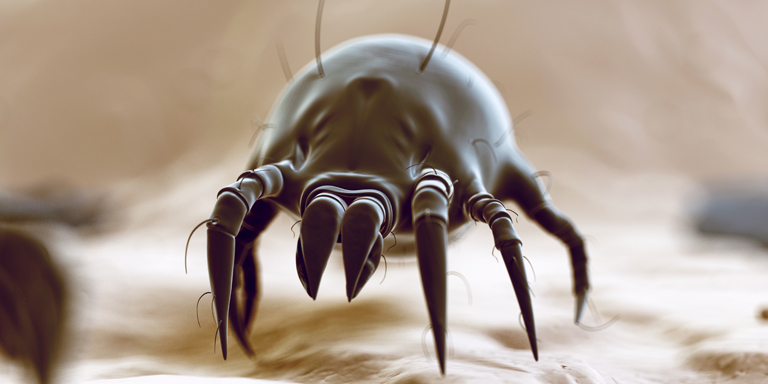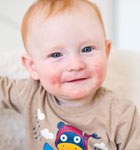House dust mite allergy
House dust mites can be found everywhere, both at home and at work - with health consequences for many allergy sufferers.

Table of contents:
The house dust mite is an arachnid about 0.3 mm in size and not visible to the naked eye. It lives and breeds primarily in places where we as humans feel comfortable – in warm and lively rooms. And especially in our beds.
Causes
House dust mites feed on human and animal skin scales. They are a constant source of allergens throughout the year and also form a substantial part of household dust. The main allergen occurs primarily in the faeces, but the body also contains allergens.
Symptoms
When the allergens come into contact with the mucous membranes in the eyes, nose, mouth and throat, sufferers develop symptoms typical of an allergic cold (allergic rhinitis) or an allergic inflammation of the conjunctiva (allergic conjunctivitis): blocked or runny nose, sneezing, red, itchy eyes. Often, the upper respiratory tract becomes chronically inflamed, as sufferers may come in contact with house dust mites all year round.
The symptoms of house dust mite allergy typically occur in the morning and are more frequent in cold months.
Diagnosis
The diagnosis is based on a thorough medical history with the aid of skin and blood tests.
Similar symptoms can occur in cases of pollen or mould allergy. Differences can mainly be identified in the place and time of onset of the symptoms. This is why it is worth observing the symptoms accurately.
Treatment
As a first step, mattress, pillows and duvet should be placed in mite-proof or anti-mite covers, sometimes known as encasings. House dust should also be minimised (see below under Tips and tricks). If necessary, the symptoms can be treated with medication, for example, antihistamines, in the form of nasal sprays, eye drops and tablets. If the above measures do not help and there are already early signs of developing asthma, the allergy specialist may recommend allergen-specific.
Tips and tricks
- Keep room temperature at 19–21°C and relative air humidity at a maximum of 50%.
- Briefly air all rooms regularly (air thoroughly, especially in cold weather).
- Wash bedlinen weekly at 60°C.
- Use mite allergen-proof mattress covers.
- Use mite allergen-proof pillowcases and duvet covers or wash washable pillowcases and duvet covers monthly at 60°C.
- Travel / holidays: take a mite allergen-proof fitted sheet or a sleeping bag with you.
- When shopping, look out for products with the Allergy Seal of Quality, these are particularly suitable for people with allergies and intolerances and are recommended by aha! Swiss Allergy Centre.
Facts and figures
6% of children and adults in Switzerland suffer from a house dust mite allergy.
There are approximately 40,000 different species of house dust mite. At our latitude, however, two species in particular are mainly responsible for causing an allergy. One mite produces up to 40 faecal droppings a day. One teaspoonful of bedroom dust contains an average of nearly 1000 mites and up to 250,000 minute droppings.
Editors: aha! Swiss Allergy Centre in co-operation with the Scientific Advisory Board.



